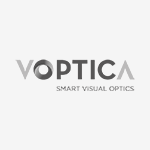Purpose: Adaptive optics vision simulators (AOVS) have been used to evaluate the impact of wavefront phase profiles on vision. The purpose of this study is to compare the clinical visual outcomes measured in patients implanted with different IOL models to those obtained by visual simulation using the phase profiles generated by the same IOLs.
Methods: A binocular AOVS was used to induce the phase profile corresponding to five different IOL designs, 2 refractive and 3 diffractive. High contrast defocus visual acuity (VA) was measured with SLOAN letters in 5 subjects with a 3.5 mm physical pupil in white light. Measurements were performed binocularly for all designs, bilaterally inducing each profile. For each case, the results of the testing in the AOVS were compared to the clinical outcomes measured in pseudophakic patients implanted with the corresponding IOL models. Data from three different clinical trials are included in this comparison, where the IOLs studied correspond to the phase profiles induced in the AOVS. These studies included bilaterally implanted patients. In this way, it is possible to compare binocular measurements performed in the AOVS with clinical measurements of binocular visual performance. In all clinical trials, high contrast defocus VA was measured between 1 and 3 months postoperatively with an ETDRS chart using trial lenses with a best distance correction in place, according to common clinical practice.
Results: The average through focus VA measured in clinical studies is highly correlated with that measured in the AOVS for the IOL models evaluated. The cross correlation coefficient between visual simulation and clinical data ranged from 0.960 to 0.994.
Conclusions: Visual results with the AOVS predict clinical outcomes following cataract surgery under binocular conditions for the different IOL designs tested. These results validate the use of laboratory adaptive optics instruments as a useful tool for developing new IOL optics and developing clinical scenarios for demonstrating the efficacy of new technologies.
Methods: A binocular AOVS was used to induce the phase profile corresponding to five different IOL designs, 2 refractive and 3 diffractive. High contrast defocus visual acuity (VA) was measured with SLOAN letters in 5 subjects with a 3.5 mm physical pupil in white light. Measurements were performed binocularly for all designs, bilaterally inducing each profile. For each case, the results of the testing in the AOVS were compared to the clinical outcomes measured in pseudophakic patients implanted with the corresponding IOL models. Data from three different clinical trials are included in this comparison, where the IOLs studied correspond to the phase profiles induced in the AOVS. These studies included bilaterally implanted patients. In this way, it is possible to compare binocular measurements performed in the AOVS with clinical measurements of binocular visual performance. In all clinical trials, high contrast defocus VA was measured between 1 and 3 months postoperatively with an ETDRS chart using trial lenses with a best distance correction in place, according to common clinical practice.
Results: The average through focus VA measured in clinical studies is highly correlated with that measured in the AOVS for the IOL models evaluated. The cross correlation coefficient between visual simulation and clinical data ranged from 0.960 to 0.994.
Conclusions: Visual results with the AOVS predict clinical outcomes following cataract surgery under binocular conditions for the different IOL designs tested. These results validate the use of laboratory adaptive optics instruments as a useful tool for developing new IOL optics and developing clinical scenarios for demonstrating the efficacy of new technologies.


